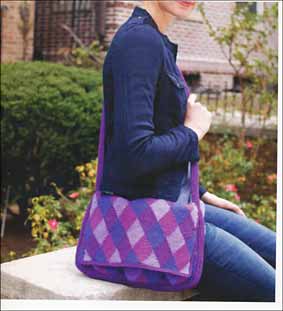Stashbuster Knits (Potter Craft) is a paperback book, 144 pages, approximately 9 x 9 inches. MSRP is $19.99; available for $13.59 as of the time of this writing through the link above. In the introduction, Leapman good-naturedly (and accurately) describes the typical knitter's stash:
Some of this treasured collection consists of one or two extra balls of yarn purchased "just in case." Much of it is just partial balls--precious bits and pieces left over from completed projects. Then there are those times a single ball of this or that lands in the stash because it's something you are curious to try out, or perhps it was an irresistible bargain, happily discovered in a hidden sale bin. And who can resist picking up yarn as a souvenir from vacations and business trips?Leapman cannily notes that although we love our stash, we also find it guilt-provoking because we know "there's just so much potential in there, if only we could figure out what to do with it." But first, she cautions, we need to know what in our stash, and be able to retrieve it. Accordingly, part 1 of the book is devoted to stash organization.
Puzzle Play
Cables and Colors
Part Two is the project section, organized by yarn weight. The first section, devoted to lace-, fingering/sock and sportweight yarns, contains 5 projects, the Boho Bangles (best for using up small quantities of leftover yarn), a striped market bag, a cowl,
Fire and Ice Cozy Cowl
a bias striped scarf and a baby kimono with zigzag stripes on the body and a geometric stripe on the sleeves.
The section on lightweight yarns (dk weight) includes the Harlequin bag,
Harlequin
Sea of Blue
a tote bag, a cabled yoke sweater, a circular-shaped medallion jacket
Roundabout
Strathaven
Urban Knitster Slouch Hat
Bravissimo Throw
One thing that is especially helpful, and appears throughout the pattern section, are little boxes with tips and suggestions for customizing the patterns. For example, the sample garment for the men's sweater is done in a blue colorway, but photos are given of two alternate colorways, one in browns, another in neutrals.
For knitters who are nervous about selecting colors, or who aren't good at imagining different color combinations together, this is a great help. Other boxes include tips on yardage (noting, for example, that colors used for one part of a sweater will require more yardage than colors used later in the pattern), ideas for tweaking size or style, and suggestions for how to best use scrap yarn in that design.
As one might expect, you'll find all the amenities that Potter Craft books are known for: color charts, schematics, clear photographs, close-ups of design details. and an easy-to-read layout. We've already covered the weight of the yarns used (everything under the sun). Sizing is generous; men's sweaters run from around a 43-inch finished chest to 61 to 64-inch finished chest, andwomen's sweaters go from around 34 to 35-inch finished bust through 3X, around 48 to 55-inch finished bust. The baby kimono is sized for 6/12/18/24 months, mittens are adult women's/men's; the child's sweater runs 2/4/6/8/10, and the rest of the items are primarily one size items (e.g. bags, throw, scarf).
Project count goes like this:
- 2 throws/blankets
- 3 women's sweaters
- 2 men's sweaters
- 2 hats
- 1 pair of mittens
- 3 bags
- 1 cowl & 1 scarf
- 1 bangle cover
- 2 shawls/stoles
- 1 baby's sweater
- 1 kid's sweater
Summing up, Melissa Leapman presents a versatile collection of good-looking patterns designed to use small amounts of yarn and other leftovers from the knitter's stash. There's a little bit of something for everyone in this book, and the technical information on organizing stash and combining colors will be helpful for knitters who feel overwhelmed by their odds and ends. And thanks to the generosity of Potter Craft, I've got a copy of Stashbuster Knits to give away. Leave a comment (one per person, please) no later than midnight, Thursday, December 1st and I'll draw a random winner the next morning. Make sure you include an email address or some other way I can get in touch with you or I'll pick another name. (I moderate comments, so if your comment doesn't show up instantly, please be patient!)




































